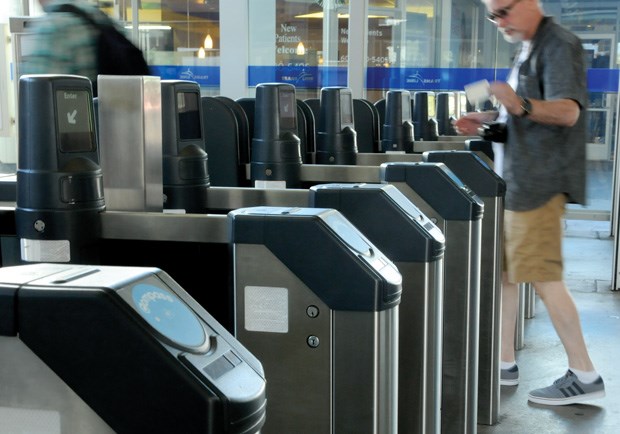City of North Van staff are concerned that recently reduced bus fares may cause transit users to avoid SeaBus trips to save money – which could further strain already overloaded bus routes.
As of Oct.5, bus riders travelling between North Vancouver and Vancouver now pay a standard one-zone fare of $2.75. A commute across the Burrard Inlet aboard the SeaBus costs $4.
That’s because as TransLink has started rolling out its new tap-in, tap-out, Compass Card system bus riders are now only required to pay one-zone fares on all buses in the region.
TransLink made the change because early testing revealed that some users of the new card forgot to “tap out” when exiting the buses and were charged for travelling multiple zones even if they’d just gone one zone.
And while the temporary end of multi-zone fares has benefited bus riders, the change doesn’t apply to the SeaBus, SkyTrain, Canada Line and West Coast Express.
On Monday CNV council voted unanimously in favour of a motion requesting that TransLink temporarily charge SeaBus users a one-zone fare instead of the two zone-fare currently in effect.
“Although the one-zone bus fare has the potential to attract new transit users, staff are concerned that a significant difference in a fare cost for the similar distance travelled across the Burrard
Inlet could potentially result in a shift of passengers from the SeaBus to buses, placing an additional burden on some already crowded bus routes,” the report stated.
Staff noted a reduced fare could attract more SeaBus users and reduce bridge backlogs. The SeaBus is also more desirable for cyclists because it can take up to six bikes, while buses carry only two.
“As such, staff recommend that a request be made to TransLink to introduce the one-zone fare relaxation for the SeaBus, in line with the one-zone bus fare.”
Staff reported that District of North Van staff expressed similar concerns and recommended that the resolution be referred to district council for their support, along with West Vancouver and City of Vancouver councils.
Coun. Don Bell said the disparity in fare prices has led to a “deflection of ridership.” “So the request that the staff have suggested that a one-zone fare be adopted including the SeaBus makes sense,” Bell said.
In response to an earlier delegation of residents who lamented the level of service provided along the 232 bus route, Bell added an addendum to the motion stating that city council express concern to TransLink about the need for improved service for that route. Bell also asked for copies of the fare request be delivered to all North Shore MLAs. “The reason I say that is because it is really the province that has created a number of problems that we have with the transit system.”
Coun. Craig Keating added a further addendum to the motion, requesting that council advocate for the construction of North Shore bus park to replace the depot on East Third Street that’s scheduled to be shut down and to write newly elected Liberal MP Jonathan Wilkinson requesting that any federal money for Lower Mainland transportation include provisions for North Shore transit.
Mayor Darrell Mussatto said North Shore transit service needs to be improved. “There were supposed to be eight SeaBuses by the year 2000. We still have two boats running in 15 to 30 minute service. That is nowhere near what we need on the North Shore. We need more bus service in general; we need the three B-Line buses,” said Mussatto, adding that the SeaBus terminal also needs repairs.
Colleen Brennan, TransLink’s vice-president of communications, said the transit authority had not yet received a fare-reduction request from the City of North Vancouver.
She emphasized that SeaBus customers are still paying the same fare. “If customers who normally take SeaBus decide to use another option, for example take a bus, we know that’s obviously an option for them. So far I can tell you that we haven’t seen that. We’re keeping a real close eye on volumes. ”
Brennan said it was important to get the Compass Card program rolled out. “All of the North Shore residents are part of all of our customers and we want them to have Compass Cards too so it’s kind of the greater good here that we are looking at and we really, really hope that our customers who do enjoy SeaBus will continue taking SeaBus.”
There are currently approximately 250,000 Compass Cards in use. By November, adult Compass Cards will be available for purchase throughout the system, including SeaBus terminals. The reloadable cards are also available at London Drugs.



